
Dealing With the Deceased Menu: 1 2 3 4 5 6 Next>>
Dealing With the Deceased in the Golden Age of Piracy, Page 4
Burial Procedure
The details of the burial of a sailor combined several land-based practices with a variety of military-style practices. Historian David J. Stewart notes that the structure of the proceedings was fairly similar between
Artist: J. G. Sturh
Cockbilled Yards on the Leopoldus Primus
(1700)
(Note that cockbilling for a funeral likely meant alternating the
tilts of the yards, which is not shown in this image.)
land and sea burials, although a few elements were modified for interment into the sea.1 He explains that the ship would be stopped for the burial, the yards (wooden cross-pieces on the masts) would be 'cockbilled' (some would be tilted up and some down) and the ship's flag would be flown at half mast.2 Adjustment of the flag is the only one of these three procedures specifically mentioned in the golden age of piracy accounts. However, stopping the ship would be a practical consideration, particularly if the crew were gathered for the service.
Stewart also notes that the amount of time the body was on view was much shorter than it was for a land-based funeral. The often morose Edward Barlow supports this, explaining that a sailor "is quickly buried, saving his friends and acquaintance that trouble to go to the church"4. Some of the burials described in the diary of chaplain Henry Teonge suggests a shortened mourning period as well. He tells of a boatswain who died in the evening was buried on land the next afternoon5 as well as a captain who died in the morning was buried the same afternoon.6
Period accounts generally don't mention any particular reason for this shortening of the mourning period. Stewart suggests a couple, including the superstitious fear of keeping the corpse on board would cause his spirit to haunt the ship. (As noted before, this is not supported by period documents.)
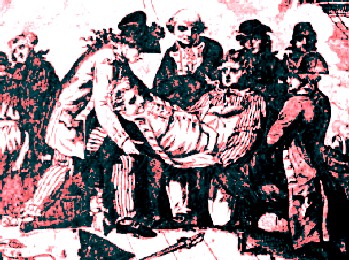
Artist: Hamilton Pollard
The Death of Lord Robert Manners, From The British Tar in
Fact and
Fiction, p. 18 (1782)
He also includes several more practical reasons:
...the lack of means for preservation would have prevented keeping the corpse for a long period before odors associated with decay became intolerable. Finally, there was no reason for an extended period of visitation, because the relatively small population aboard ship would not need a lengthy period in order to pay last respects and relatives would not need time to travel from distant places.7
Stewart suggests a couple of other facets of a sea-based ceremony not found in any of the period accounts.
During the service, the placement of personnel corresponded to the social hierarchy aboard ship. The crew gathered in the waist or on the booms. Officers stood on the quarterdeck, forbidden territory for ordinary sailors unless they had duties there. Officers and crew showed respect for the deceased by removing their hats. As in other parts of the burial at sea ritual, the dead sailor's messmates played the part of the family, flanking the body as it lay at the ship's side awaiting burial.8
Although these things aren't supported by the period accounts, it may be because the period authors believed such they would be inherently understood. It is sometimes suggested that pirate ships would have less need for such hierarchical rules, although a ship without rules would not be very effectively run or ready for action. Like most seamen, many pirates would have been in the navy at some point, so it is likely that they too would inherently understand such procedures.
A variety of other elements of the burial ceremony are discussed in several of the period accounts. These include setting the ship's flag at half mast, covering the casket of the deceased with a flag and/or weapons and other items related to the decedent's job, the sounding of a funeral knell, firing of guns, playing trumpets, prayers for the dead and putting the body into water for a burial at sea. Each of these bear more detailed examination.
1 David J. Stewart, The Sea Their Graves, 2011, p. 121; 2 Stewart, p. 122; 3 Stewart, p. 121; 4 Edward Barlow, Barlow's Journal of his Life at Sea in King's Ships, East and West Indiamen & Other Merchantman From 1659 to 1703, p. 214; 5 Henry Teonge, The Diary of Henry Teonge, Chaplain on Board H.M.’s Ships Assistance, Bristol, and Royal Oak, 1675-1679 Teonge, 1825, p. 100; 6 Teonge, p. 257; 7 Stewart, p. 121; 8 Stewart, p. 123
Burial Procedure - Flag at Half Mast
The practice of flying flags at half mast finds its most direct roots in the Royal Naval practice of doing so on the
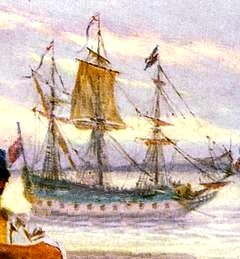
Aft Flag at Half Mast
anniversary of the execution of King Charles I which began after the restoration of the monarchy in 1660.1 (Charles' death had tremendous impact on British society and was largely responsible for the popularization of memento mori items that lasted well into the golden age of piracy.) Before that time, black sails or black flags hoisted on ships were used to indicate mourning.2
Half-mast refers to flying a flag two-thirds of the way up the flagpole, allowing at least the height of the flag between the top of the flag and the top of the flagpole. This is supposedly done to provide "space for the traditionally invisible flag of Death."3 Whether this reason for flying a flag at half-mast was recognized during the golden age of the pirates or not isn't clear.
Two period accounts mention the flag being flown at half mast for a burial. When his brother and another sailor were buried at sea in April of 1709, Woodes Rogers noted, "We hoisted our Colours but half-mast up"4. Merchant sailor Thomas Phillips explains that during the burial at sea of his brother in January of 1694, "the colours of our own ship and [a nearby] East India merchant being lower’d half-mast down"5. One of the pirate accounts also mentions flying their flag, although they don't specify whether it was at half mast. The vivid account of the burial of pirate captain John Halsey notes that their 'colours [flags] were flying' during the captain's burial ceremony.6
1,2 "Origin of the Term 'Half-Mast' or 'Half-Staff', www. crwflags.com, gathered 10/10/15; 3 Graham Bartram, "A Guide to Flag Protocol in the United Kingdom", National Association of Civic Officers Website, p. 7, gathered 10/10/15; 4 Woodes Rogers, A Cruising Voyage Round the World, 2004, p. 89-90; 5 Thomas Phillips, 'A Journal of a Voyage Made in the Hannibal', A Collection of Voyages and Travels, Vol. VI, Awnsham Churchill. ed., p.196; 6 Captain Charles Johnson, The History of the Pirates, 1826, p. 103
Burial Procedure - Flag as a Pall
A pall is a piece of cloth laid over the coffin or remains (when there is no coffin) before it is buried. During funerals held on land at this time, it was normally a piece of black cloth or velvet.1 Using the flag as a pall is recognized today as a military tradition. This is usually suggested to have begun during the Napoleonic wars, almost 100 years after the time-period of interest.2 Flags were used as palls during both military and non-military burials at sea during the golden age of pirates.
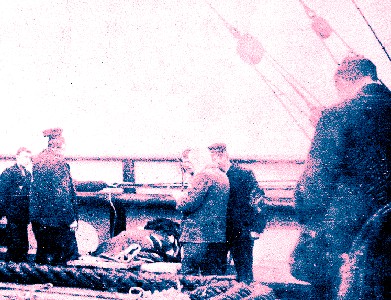
Flag on Coffin For Burial at Sea Aboard the Loch Tay (19thc)
Historian David Stewart explains a flag being used as a pall is meant both a sign of respect for the dead as well as a cover for the corpse which provides "another boundary layer between the living and the dead."3
Using a flag as a pall is specifically mentioned as something done for those serving in the British Royal Navy by chaplain Henry Teonge. He explains that when their boatswain died in December of 1675, "He was nobly buryed, and like a souldyer. He had a neate coffin, which was covered over with on[e] of the King's jacks [British national flags]."4
However, a flag was also used as a pall during a merchant ship ceremony. When the supercargo of his merchant ship died in 1702, Francis Rogers noted that the funeral was performed "with the usual ceremony of our colours and his sword and scabbard over the coffin"5. Whether 'the usual ceremony' refers to a usual military tradition or usual sea tradition isn't clear.
The pirates also coopted this element in at least one of their funerals. When pirate captain John Halsey was buried in 1716, his coffin "was covered with a ship's jack [flag]"6. Although details are not given, two of the others pirate burials were said to be buried in a manner similar to Halsey: Captains Thomas White7 and John Cornelius8, so it is quite possible they also had their flags draped over their coffins.
1 Edward Phillips, "Pagens - Pallets", The New World of Words, 1706, not paginated; 2 Megan Smith, "What is the Meaning of a Flag-Draped Coffin?", ehow.com, gathered 10/11/15; 3 David J. Stewart, The Sea Their Graves, 2011, p. 120; 4 Henry Teonge, The Diary of Henry Teonge, Chaplain on Board H.M.’s Ships Assistance, Bristol, and Royal Oak, 1675-1679 Teonge, 1825, p. 100-1; 5 Francis Rogers, "The Journal of Francis Rogers", Three Sea Journals of Stuart Times, Bruce S. Ingram, editor, 1936, p. 169; 6 Captain Charles Johnson, The History of the Pirates, 1826, p. 103; 7 Johnson, p. 122; 8 Johnson, p. 165
Burial Procedure - Covering the Casket With Weapons and Signs of Office
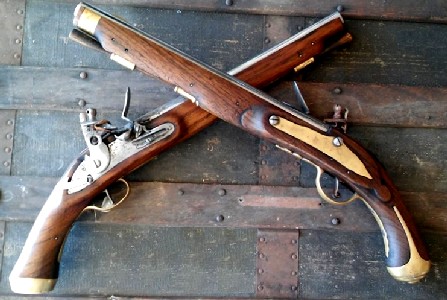
Photo: Jeremy Nichols - Crossed Pistols
Caskets were sometimes covered with symbols of the decedent's station on the ships. Chaplain Henry Teonge said that at the funeral of boatswain Richard Capps, his coffin, "was covered over with on[e] of the King's jacks, and his boarson's sylver whisle and chaine [bosun's silver whistle and chain] layd on the top, (to shew his office,) betweene 2 pistolls crost with a hangar [sword] drawne."1
Weapons are the most frequently mentioned item for setting on a sailor's coffin during this time. Francis Rogers explains that during their supercargo's burial ceremony, they put "his sword and scabbard over the coffin"2.
Not ones to miss a trend, the pirates had Captain John Halsey's "sword and pistol laid on his coffin"3. Note that all of these men held offices on their ships.
1 Henry Teonge, The Diary of Henry Teonge, Chaplain on Board H.M.’s Ships Assistance, Bristol, and Royal Oak, 1675-1679 Teonge, 1825, p. 100-1; 2 Francis Rogers, "The Journal of Francis Rogers", Three Sea Journals of Stuart Times, Bruce S. Ingram, editor, 1936, p. 169; 3 Captain Charles Johnson, The History of the Pirates, 1826, p. 103
Burial Procedure - The Funeral Knell
"Knell, the sound of a Bell, a Passing Bell." ("Kneck – Knights of the Bath", Glossographia Anglicana nova, 1707, not paginated)
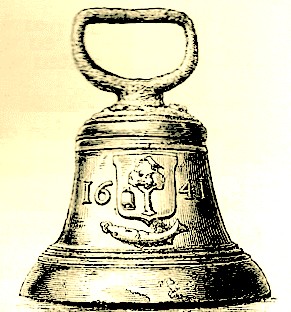
The Glascow Died or Passing Bell (1641)
The ringing of the passing bell to announce someone's death is an ancient tradition dating to before the 7th century in England.1 It was "rang whilst persons were passing from this life to that beyond, and it was rung [so] that all who heard it might address prayers to heaven and the saints for the soul then being separated from the mortal body."2
Francis Grose adds another purpose for ringing the passing bell which is from the 13th century. He explains that the second function of the bell was "to drive away the evil spirits who stood at the bed's-foot, and about the house, ready to seize their prey, or at least to molest and terrify the soul in its passage: but by the ringing of that bell, they were kept aloof; and the soul, like a hunted hare, gained the start, or had what is by sportsmen called Law."3 Grose dismisses this aspect of the passing bell, noting that it was really being used to get the "high price demanded for tolling the greatest bell of the church; for, that being louder, the evil spirits must go farther off to be clear of its found, by which the poor soul got so much more the start of them: besides, being heard farther off, it would likewise procure the dying man a greater number of prayers."4
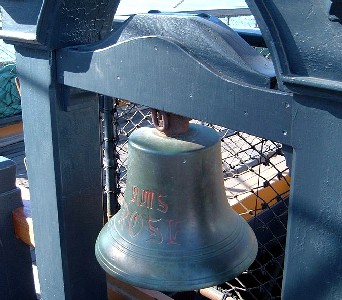
Photo: Wiki Uswer Broken Sphere
Replica of a 1757 Ship's Bell on HMS Surprise
Whatever its original purpose, the usual passing bell was not used on a ship. Edward Barlow noted that when a sailor dies, he is buried quickly, "saving his friends and acquaintance that trouble to go to the church and have his passing bell rung"5. Barlow suggests that another part of a naval burial ceremony served the same purpose as the passing bell during one burial, noting that "we fire each of us ten pieces of ordnance for a funeral knell"6. Chaplain Henry Teonge echoes this idea, explaining during a description of burying a lieutenant, "Severall peales of greate gunns rang his funerall knell."7
However, this does not mean a bell was never used during ship-based burials. David Stewart explains, "The tolling of the ship's bell and bosun's call signaled all hands that it was time to bury the dead."8 Boteler's Dialogues, first published in 1634, advised that "upon the death either of the Captain, Master, Master-Gunner, or any chief officer, that when the corpse is thrown overboard to its sea grave, to ring the knell"9, most likely referring to the ship's bell.
1 William Andrews says St. Bede the Venerable who died in 731 provide one of the earliest accounts of the ringing of a passing bell when "a sister in a distant monastery thought that she heard in her sleep the well-known sound of the passing bell.", p. 10; 2 William Andrews, Old Church Lore, 1891, p 10; 3,4 Francis Grose, A Provincial Glossary, 1787, p. 66-7; 5,6 Edward Barlow, Barlow's Journal of his Life at Sea in King's Ships, East and West Indiamen & Other Merchantman From 1659 to 1703, p. 214; 7 Henry Teonge, The Diary of Henry Teonge, Chaplain on Board H.M.’s Ships Assistance, Bristol, and Royal Oak, 1675-1679 Teonge, 1825, p. 270; 8 David J. Stewart, The Sea Their Graves, 2011, p. 122; 9 Nathaniel Boteler [Butler], Boteler’s Dialogues, Edited by W. G. Perrin, Navy Records Society, 1929, p. 268
Burial Procedure - Trumpets
Trumpets were sometimes sounded at the burial of officers and other important people who died shipboard. This goes back at least as far as the burial at sea of Sir Francis Drake in 1696. An
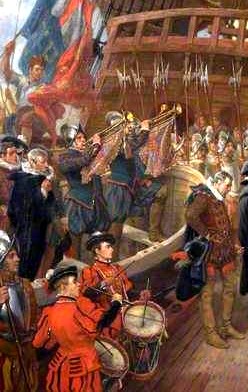
Artist: Thomas Davidson
Trumpets & Mourners at Francis Drake's Burial
at Sea in 1596 (Late 19th/early 20th Century)
account of that funeral explains that "Trumpets [were played] in dolefull manner echoing out this lamentation for so great a losse"1.
Many people associate the bugle song Taps with funerals, although it was composed long after the golden age of piracy, being first played on an American Civil War battlefield in 1862 to indicate it was the end of the day. It wasn't regularly used in funerals for almost another thirty years.2
The British military usually plays a song called The Last Post at funerals. It also began as a tune to indicate the end of the day - in this case it was played in during the inspection by a camp duty officer in the 18th and 19th centuries.3
While neither of those songs date back to the early 18th century, the song that they were based on could have been used.
Both the Last Post and Taps share a common lineage. Each are derivatives of a Dutch tune from the 1600s called the Taptoe. This melody announced to a regiment that the beer taps were being closed for the night, again marking the end of the day.
It's likely that English troops adopted a variation of the Taptoe while serving in the Netherlands sometime in the 17th or 18th centuries.4
Of course, the tune that would have been played during the golden age of piracy at a funeral can't be said for certain based on the limited evidence that exists. What is clear is that the music played during a burial ceremony would have been appropriate to
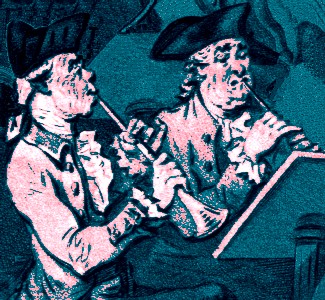
Artist: Thomas Rowlandson & Mission
Trumpet Players, From Vaux-Hall (1785)
the event based on the period descriptions. Naval chaplain Henry Teonge explained that at one funeral he presided over there were "8 trumpetts sownding dolefully, wherof the 4 in the first ranke began, and the next 4 answered; so that ther was a continued dolefull tone from the ship to the shoare, and from thence to the grave."5
Once a burial ceremony finished, the trumpets played a different tune. For the interment of their boatswain, Teonge says "as soone as wee were out of the church yard the trumpetts sounded merry levitts [levets - rousing trumpet blasts or music] all the way."6 Teonge noted a similar use of trumpets when he attended the funeral of a victualler Mr Toogood where "having finished the ceremony, the trumpets sounded 3 levetts at the grave"7.
Merchant captain Thomas Phillips notes that during the burial of his brother, while they were rowing the corpse away from the ship for a sea burial, "our trumpets and drums [were] sounding and beating, as is customary upon such melancholy occasions."8 It is interesting that this 'customary' procedure is not mentioned in any other burial accounts, including the two others mentioned in Phillip's book.
1 A Full Relation of Another Voyage into the West Indies made by Sir Francis Drake, Printed at London for Nicholas Bourne, 1652, p. 58; 2,3,4 "Final Notes — ‘Taps’, ‘The Last Post’, and Other Military Funeral Tunes", militaryhistorynow.com, gathered 10/12/15; 5,6 Henry Teonge, The Diary of Henry Teonge, Chaplain on Board H.M.'s Ships Assistance, Bristol, and Royal Oak, 1675-1679, 1825, p. 101; 7 Teonge, p. 278

